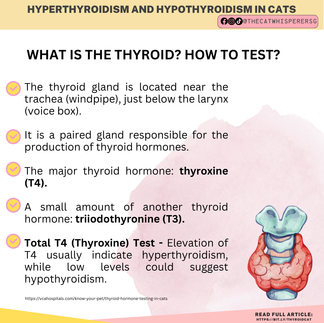
One area of concern that often goes unnoticed until symptoms become severe is thyroid function. The thyroid gland, located in the neck, plays a crucial role in regulating your cat's metabolism.
When something goes wrong with this gland, it can lead to either hyperthyroidism or hypothyroidism—both of which can significantly affect your cat’s well-being.
Let's talk about Hyperthyroidism and Hypothyroidism in Cats, what to look out for and what you can do to help your cat.
What is the Thyroid Gland?
The thyroid gland is located near the trachea (windpipe), just below the larynx (voice box). It is a paired gland that is responsible for the production of thyroid hormones.
The major thyroid hormone produced by the thyroid gland is thyroxine (T4). A small amount of another thyroid hormone, triiodothyronine (T3), is also made by the thyroid gland.
Hyperthyroidism in Cats
Hyperthyroidism is the most common thyroid disorder in cats, especially in middle-aged to senior cats. It occurs when the thyroid gland produces too much of the thyroid hormone, leading to an accelerated metabolism.
Symptoms of Hyperthyroidism:
Weight loss despite increased appetite: Your cat may start eating more than usual but still lose weight.
Increased thirst and urination: Hyperthyroid cats often drink a lot more water, which leads to increased urination.
Hyperactivity or restlessness: You might notice your cat pacing, being more vocal, or seeming agitated.
Diarrhoea or vomiting: Digestive upsets are common as the metabolism works overtime.
Unkempt coat: Despite grooming, a hyperthyroid cat’s fur may look dull or unkempt due to poor health.
Heart problems: Over time, untreated hyperthyroidism can strain the heart, causing rapid heart rate (tachycardia) and even heart failure.
Diagnosis and Treatment:
Blood tests can measure thyroid hormone levels. On top of the regular blood tests, you should request for Total T4 (Thyroxine) Test - Elevation of T4 usually indicate hyperthyroidism, while low levels could suggest hypothyroidism.
Management of Hyperthyroidism:
Medication: Daily pills to control the production of thyroid hormones.
Radioactive iodine therapy: This treatment targets and destroys overactive thyroid tissue. (In Singapore, avaiable at The Animal Doctors.)
Surgery: In some cases, the affected thyroid gland may need to be removed.
Diet: A prescription low-iodine diet may help manage the condition by reducing hormone production, e.g. Hill's Prescription Y/D
Hypothyroidism in Cats
Hypothyroidism, on the other hand, is when the thyroid gland produces too little thyroid hormone, leading to a slow metabolism. This condition is rarer in cats.
Symptoms of Hypothyroidism:
Weight gain despite a normal or reduced appetite: Your cat may start gaining weight without eating more.
Lethargy: Cats with hypothyroidism may become unusually sluggish or disinterested in activities they once enjoyed.
Cold intolerance: Hypothyroid cats might seek out warm places more often, like sitting next to heaters or sleeping under blankets.
Dry skin or coat: You might notice dry, flaky skin and a dull, thinning coat.
Constipation: Slowed metabolism can affect the digestive system, leading to constipation.
Diagnosis and Treatment:
As with hyperthyroidism, blood work should be run.
Management of Hyperthyroidism:
Thyroid hormone replacement therapy: Daily pills can replace the missing hormones, helping to restore normal metabolism.
As with all other medical conditions, early detection is key. If your cat is showing any unusual behaviors, such as weight changes or changes in energy levels, it's crucial to consult your veterinarian for a thorough examination.
Downloadable Infographics also available on Instagram: @thecatwhisperersg
Like, Share & Follow!

















Comments